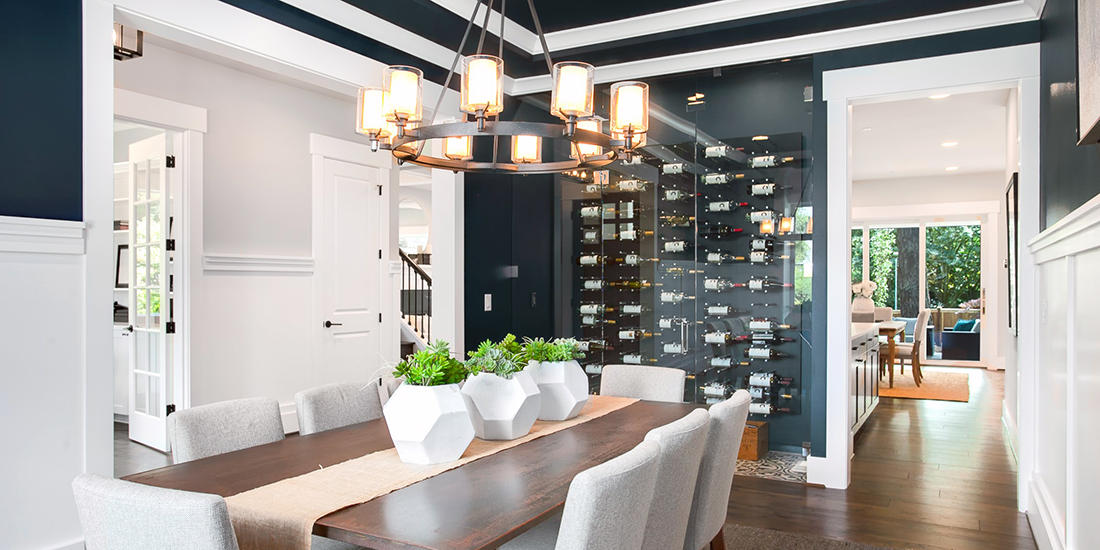
By Doug Smith
Q: After years of waiting, I finally have the space to build a climate-controlled wine cellar. What do I need to know to properly prepare the space?
A: There are few things in life more pleasurable than having a place to store wine for guests or for our own enjoyment. When it comes to cellars, the most important thing is temperature and humidity—it is essential to maintain a temperature between 55 and 59 degrees and humidity between 45% and 65%. Here are the steps for getting it just right the first time.
-
Frame the walls and ceiling.
You’ll need standard 2x4 studs or 2x6 studs for the walls. The general rule to remember is the thicker the walls the better the insulation. Effective insulation will keep the cellar’s temperature consistent.
-
Insulate the room.
Insulation is critical and required for maintaining the desired temperature. The best method for properly insulating the space is using closed cell foam on the walls and ceiling. You can also use fiberglass or rigid insulation in each stud bay—2x4 or 2x6 studs will determine its thickness. See step 8 before you begin.
-
Install a vapor barrier.
A vapor barrier is required to keep humidity in check and prevent mold—it separates the outside environment from the wine cellar environment. Closed cell foam includes a vapor barrier with the insulation, so if you use it you won’t need an additional barrier. If you use fiberglass or rigid insulation, install six-millimeter plastic sheeting to the hot side of the cellar walls and ceiling. The most common method is to wrap the entire interior, leaving the plastic loose in the stud cavity so insulation can be placed between each stud.
-
Cover walls and ceiling.
The cellar’s decor will determine the interior wall and ceiling covering. Usually, drywall is applied and painted with latex paint to match a color scheme. Wood paneling can be employed to match wood wine racking material. Stone or rock accent walls are also a popular way to spruce up wine cellars with a unique look. Be creative!
-
Install flooring.
Common floor types include slate, tile, marble, and wood. NEVER use carpet; mold loves it! As with wall coverings, flooring is typically determined by the overall decor and color.
-
Install cellar doors.
An exterior grade (1 ¾”) door must be installed as a cellar door. It is important that weather stripping is attached to all four sides of the door. A bottom sweep or threshold is required for a proper seal. Doors with glass inserts must be double pane-tempered glass.
-
Using glass windows or all-glass walls:
It is very chic to add a glass wall or all-glass door to your wine cellar. Full glass walls must be half an inch thick and sealed on all sides. All-glass doors must have rubber seals on all four sides. IMPORTANT: Adding glass will require a larger cooling system to compensate for glass’s lack of insulation.
-
Install a climate-controlled system.
When deciding on the proper climate-controlled system, it is best to consult with a wine cellar professional. They will conduct a heat load analysis (called BTU load) to determine the proper equipment size for your space. Cooling options include through-the-wall systems, split systems, and ducted options. The cellar configuration will determine what type of cooling system is best to store your prized wine collection properly. Note: If a split system is your best option, copper piping will need to be installed before you add insulation and a vapor barrier.
Now that you’ve got the basics down, your wine cellar designer can help you create a beautiful cellar for your collection, including a variety of aesthetic choices and wood and metal wine racking options. While there are a lot of technical details to remember, you’ll quickly discover that nothing is quite as fun as creating your very own wine cellar. Enjoy!
Doug Smith is the president and chief designer of Rhino Wine Cellars & Cooling Systems and a member of the Master Builders Association of King and Snohomish Counties (MBAKS). If you have a home improvement, remodeling, or residential homebuilding question you’d like answered by one of MBAKS’ more than 2,900 members, write to homework@mbaks.com.